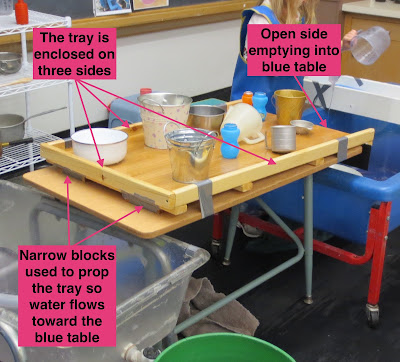One of the earliest apparatus I built was knob water ramp. It was made with scrap wood from my basement. The knobs were short dowel pieces made by cutting old broom handles I had been collecting. I had two main reasons for making this apparatus: 1) I wanted to create the sound of water flowing over rocks, like a babbling brook; 2) I wanted to arrange the knobs so the children would see a dispersal pattern as the water flowed down the ramp.
The idea came from a water fountain in the Twin Cities where I live. The water bubbles up out of the top and tumbles over the bricks on its way down the sides of the fountain.
I often ended up re-taping the apparatus daily because by the end of the day it had slipped down into the water, which is not good for wood.
One
time during play the bottom of the tray actually came loose. In essence, the ramp became a
teeter-totter. That gave the children more agency with moving the water
on the ramp.
However,
I was not comfortable with the ramp rocking back and forth. The
picture below illustrates why. The child's head on the right came
awfully close to the corner of the ramp.
Credit does have go to both of these children because no one got
bonked. The child manipulating the ramp did it slowly and carefully and
the child whose head is so close to the corner seemed to know the
corner was near his head and simply avoided it.Though it may look like the child pictured above was focusing on the dispersal pattern created by the dowels, I am not sure. His pour was much too fast for him to see the pattern. He surely heard the water splashing over the knobs and dropping into the water like a babbling brook.
Below is a video of a child pouring water down the ramp. As the water flows over the knobs and off the ramp into the tub, there is a zen-like aural component created by the action of the water.
Pouring Water Down the Water Ramp from Thomas Bedard on Vimeo.
So I am not so sure about how much the children noticed the dispersal pattern. That is not big deal because that was my agenda. I do think there was also a certain attraction to the sound the water made rippling down the ramp. Again, though, that was my agenda. The driving force behind the children's play came from the children themselves because they have this natural compulsion to pour water down ramps. (See Axiom #4 on the right column of this blog.)
One thing that I have learned over the years is that inclines connect children in play. When someone pours at the top, there is often someone positioned at the bottom to receive the pour. Below is an example of this. One child poured water down the ramp. The water slowly worked its way around the knobs to the bottom. When the water reached the bottom of the ramp, the child kneeling next to the tub started rubbing the water on the board with her soapy hand.
Knob ramp play from Thomas Bedard on Vimeo.
How intentional was this play connection? The child at the bottom clearly waited for the child on top to pour the water down the ramp. The child on the top seemed more interested in pouring and watching the water flow down the ramp. Maybe there are different degrees of play connections in any given play episode. And maybe those different degrees of play connections help move the play along until the play morphs into something else or simply runs it course.
What do you think?



































